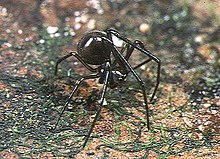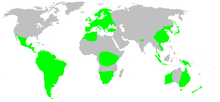Anapidae
| Anapidae Temporal range:
| |
|---|---|

| |
| C. lyugadinus,female from Okinawa | |

| |
| C. lyugadinus,male | |
| Scientific classification | |
| Domain: | Eukaryota |
| Kingdom: | Animalia |
| Phylum: | Arthropoda |
| Subphylum: | Chelicerata |
| Class: | Arachnida |
| Order: | Araneae |
| Infraorder: | Araneomorphae |
| Family: | Anapidae Simon,1895 |
| Diversity | |
| 58 genera,232 species | |

| |
| Synonyms | |
|
Micropholcommatidae | |
Anapidaeis a family of rather smallspiderswith 232 describedextantspecies in 58 genera.[1]It includes the former family Micropholcommatidae as the subfamilyMicropholcommatinae,[2]and the former family Holarchaeidae. Most species are less than 2 millimetres (0.079 in) long.[3]
They generally live in leaf litter and moss on the floor of rain forest. Many build orb webs with a diameter less than 3 centimetres (1.2 in). In some species, such asPseudanapis parocula,thepedipalpsof the female are reduced to coxal stumps.[3]
Description
[edit]Spiders of this family are very small, usually less than two millimeters long, and lack acribellum.They can have either six or eight eyes, the rear median eyes either reduced or missing. The carapace is modified so that the eyes are raised higher than usual. Color can range from reddish brown to yellowish brown. Both margins ofcheliceraehave teeth. The legs are short and spineless. The labium has a spur that extends between the chelicerae and can be seen when the chelicerae are spread.[4]
Distribution
[edit]Anapidae are found worldwide, particularly in South America, Africa, Asia, Australia and New Zealand. Few genera occur in North America or Europe. OnlyComaroma simoniand the three species ofZangherellaare found inEurope;Gertschanapis shantziandComaroma mendocinoare found in the United States.[5]
Systematics
[edit]The family Micropholcommatidae was synonymized with this family by Schütt in 2003[6]and by Lopa et al. in 2011,[7][2]a change that has been accepted by theWorld Spider Catalog.[5]Similarly, the family Holarchaeidae was synonymized by Dimitrov et al. in 2017, and likewise accepted by the World Spider Catalog.[8]
Genera
[edit]As of January 2023[update],theWorld Spider Catalogaccepts the followingextantgenera:[1]
- AcroblepsHickman, 1979— Australia
- AlgidiellaRix & Harvey, 2010— New Zealand
- AnapisSimon, 1895— South America, Central America, Mexico, Jamaica
- AnapisonaGertsch, 1941— South America, Central America, Saint Vincent and the Grenadines, Mexico
- AustropholcommaRix & Harvey, 2010— Australia
- BorneanapisSnazell, 2009— Indonesia
- CaledanapisPlatnick & Forster, 1989— New Caledonia
- ChasmocephalonO. Pickard-Cambridge, 1889— Australia
- ComaromaBertkau, 1889— Asia, United States
- ConculusKishida, 1940— Papua New Guinea, Asia
- CrassanapisPlatnick & Forster, 1989— Chile, Argentina
- CrozetulusHickman, 1939— Africa
- DippenaariaWunderlich, 1995— South Africa
- ElanapisPlatnick & Forster, 1989— Chile
- EnielkenieOno, 2007— Taiwan
- EperiellaRix & Harvey, 2010— Chile, Australia
- EpigastrinaRix & Harvey, 2010— Australia
- EterosonychaButler, 1932— Australia
- ForsteriolaBrignoli, 1981— Burundi, Rwanda, Congo
- GaiziapisMiller, Griswold & Yin, 2009— China
- GertschanapisPlatnick & Forster, 1990— United States
- GigiellaRix & Harvey, 2010— Australia, Chile
- GuiniellaRix & Harvey, 2010— Papua New Guinea
- HickmanapisPlatnick & Forster, 1989— Australia
- HolarchaeaForster, 1955— Australia, New Zealand
- MandanapisPlatnick & Forster, 1989— New Caledonia
- MaxanapisPlatnick & Forster, 1989— Australia
- MetanapisBrignoli, 1981— Africa, Nepal
- MicropholcommaCrosby & Bishop, 1927— Australia
- MinanapisPlatnick & Forster, 1989— Chile, China, Argentina
- MontanapisPlatnick & Forster, 1989— New Caledonia
- NormplatnickaRix & Harvey, 2010— Australia, Chile
- NortanapisPlatnick & Forster, 1989— Australia
- NovanapisPlatnick & Forster, 1989— New Zealand
- OctanapisPlatnick & Forster, 1989— Australia
- OlganiaHickman, 1979— Australia
- ParanapisPlatnick & Forster, 1989— New Zealand
- PatelliellaRix & Harvey, 2010— Australia
- PecanapisPlatnick & Forster, 1989— Chile
- PseudanapisSimon, 1905— Asia, Germany, South America, Africa, Mexico, Central America, Papua New Guinea
- PuaForster, 1959— New Zealand
- QueenslanapisPlatnick & Forster, 1989— Australia
- RaveniellaRix & Harvey, 2010— Australia
- RayforstiaRix & Harvey, 2010— New Zealand, Australia
- RisdoniusHickman, 1939— Australia
- SheranapisPlatnick & Forster, 1989— Chile
- SinanapisWunderlich & Song, 1995— China, Laos, Vietnam
- SofanapisPlatnick & Forster, 1989— Chile
- SpinanapisPlatnick & Forster, 1989— Australia
- TaliniellaRix & Harvey, 2010— New Zealand
- TaphiassaSimon, 1880— Australia, New Zealand, Sri Lanka
- TasmanapisPlatnick & Forster, 1989— Australia
- TeutoniellaBrignoli, 1981— Chile, Brazil
- TinytrellaRix & Harvey, 2010— New Zealand
- TricellinaForster & Platnick, 1989— Chile
- VictanapisPlatnick & Forster, 1989— Australia
- ZangherellaCaporiacco, 1949— Europe, Algeria, Turkey
- ZealanapisPlatnick & Forster, 1989— New Zealand
There are also genera only known as fossils, typically inBaltic amber:[9]
- †BalticoromaWunderlich, 2004
- †BalticonopsisWunderlich, 2004
- †CenotextricellaPenney in Penney et al., 2007
- †DeanoorapsisPenney, 2020
- †DubianapisWunderlich, 2004
- †FlagellanapisWunderlich, 2004
- †FossilanapisWunderlich, 2004
- †PalaeoanapisWunderlich, 1988
- †RuganapisWunderlich, 2004
- †SaxonanapisWunderlich, 2004
- †TuberanapisWunderlich, 2004
See also
[edit]References
[edit]- ^ab"Family: Anapidae Simon, 1895".World Spider Catalog.Natural History Museum Bern.Retrieved2023-01-19.
- ^abHormiga, Gustavo & Griswold, Charles E. (2014)."Systematics, Phylogeny, and Evolution of Orb-Weaving Spiders".Annual Review of Entomology.59(1): 487–512.doi:10.1146/annurev-ento-011613-162046.PMID24160416.
- ^abMurphy, F; Murphy, J. (2000). "An introduction to the spiders of South East Asia with notes on all the genera".Malaysian Nature Society Kuala Lumpur.
- ^Song, D.X.; Zhu, M.S.; Chen, J. (1999).The Spiders of China.Shijiazhuang: Hebei University of Science and Technology, Publishing House. p. 149.
- ^ab"Family: Anapidae Simon, 1895".World Spider Catalog.Natural History Museum Bern.Retrieved2017-03-03.
- ^Schütt, K. (2003), "Phylogeny of Symphytognathidae",Zoologica Scripta,32:129–151,doi:10.1046/j.1463-6409.2003.00103.x,S2CID84908326
- ^Lopardo, L.; Giribet, G. & Hormiga, G. (2011), "Morphology to the rescue: molecular data and the signal of morphological characters in combined phylogenetic analyses — a case study from mysmenid spiders (Araneae, Mysmenidae), with comments on the evolution of web architecture",Cladistics,27(3): 278–330,doi:10.1111/j.1096-0031.2010.00332.x,PMID34875780,S2CID85647657
- ^"Family: Holarchaeidae Forster & Platnick, 1984".World Spider Catalog.Natural History Museum Bern.Retrieved2020-09-18.
- ^Dunlop, J.A.; Penney, D. & Jekel, D. (2023)."A summary list of fossil spiders and their relatives, version 23.5"(PDF).World Spider Catalog.Natural History Museum Bern.Retrieved16 August2024.
Ramirez, M.J.; Platnick, N.I. (1999)."OnSofanapis antillanca(Araneae, Anapidae) as a kleptoparasite of austrochiline spiders (Araneae, Austrochilidae) "(PDF).Journal of Arachnology.27(2): 547–549.
